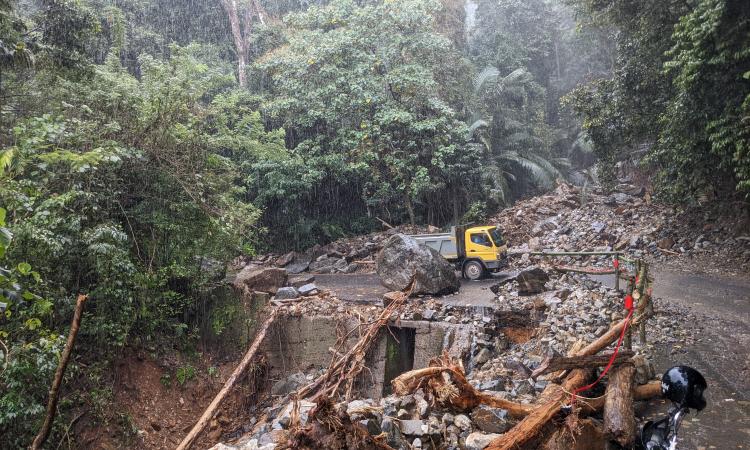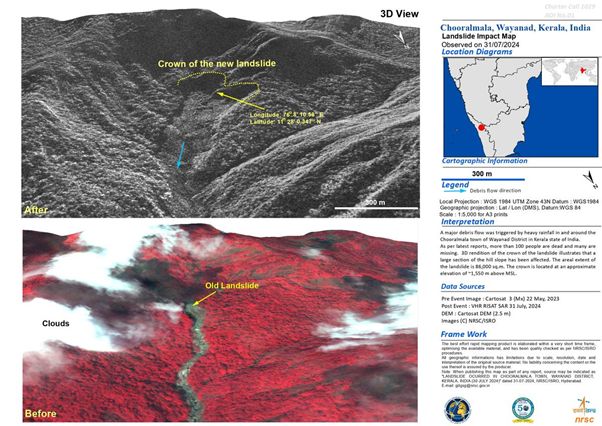
The serene and picturesque district of Wayanad, Kerala, recently witnessed a catastrophic landslide, leading to immense loss of life and property. On the fateful night of July 30, 2024, Wayanad, known for its lush greenery and scenic landscapes, was struck by a massive landslide. Triggered by incessant rainfall over several days, the landslide wreaked havoc in the Meppadi area in Chooralmala and Mundakkai, burying houses, roads, and farmlands under tons of mud and debris.
The immediate aftermath was a scene of devastation – collapsed buildings, uprooted trees, and a desperate search for survivors. Rescue teams are battling treacherous conditions, including waterlogged terrain, as they comb through the ruins of homes and buildings searching for missing people.
NRSC has quantified the destruction caused by the Wayanad landslide through before-and-after images, indicating a land displacement of around 86,000 square meters in Chooralmala. High-resolution satellite images from July 31st provide a clear picture of the landslide in Wayanad, revealing an 8-kilometer debris flow from its origin to its endpoint. The powerful force of the debris flow has widened the Iruvaniphuza River, causing its banks to collapse and damaging nearby homes and infrastructure, according to NRSC. The NRSC images reveal evidence of an earlier landslip that got reactivated in the same area, highlighting its susceptibility to such events.

A staggering 49.7% of Kerala, equivalent to 19,301 square kilometers, is susceptible to landslides, according to the Geological Survey of India. According to the National Centre for Earth Sciences, a significant portion of Kerala – approximately 4.71% – is classified as highly susceptible to landslides. An additional 9.77% of the state is considered to be at low risk. The talukas of Devikulam, Vythiri, Nilambur, Mannarkkad, and Ranni are hotspots for landslide occurrences.
Out of the thirty most landslide-susceptible districts nationwide, ten are in Kerala, including Wayanad at number thirteen, as per the landslide atlas released by the Indian Space Research Organisation's (ISRO) National Remote Sensing Centre last year. A staggering 59% of Kerala's landslides occur in plantation areas, highlighting the region's vulnerability. Studies reveal that 90,000 square kilometers of the Western Ghats and Konkan coast are susceptible to landslides. The report emphasises the heightened risk to residents in this region, particularly in densely populated Kerala.
Kerala has grappled with severe landslide crisis in the past also, with 2,239 incidents recorded between 2019 and 2022. These disasters have resulted in significant loss of life, widespread agricultural devastation, and a substantial financial burden on the state government. A Geological Survey of India report details the tragic loss of 167 lives in five major landslides between 2019 and 2021. However, the Kerala State Disaster Management Authority has reported no major landslide incidents in the past two years.
Climate change, coupled with the state's fragile terrain and deforestation, created the ideal conditions for the catastrophic landslides in Wayanad. The Wayanad tragedy, a direct result of relentless rains underscores the vulnerabilities of hilly regions to natural disasters. Global warming has intensified monsoon patterns, with increased frequency and intensity of rainfall events. Climate change-induced anomalies have made traditional weather predictions unreliable, leaving communities unprepared for such extreme events.
Wayanad, receiving heavy monsoon rains annually, experienced a significant deviation from its usual pattern, with intense downpours within a short span, leading to soil saturation and eventual collapse. A research from 2022 “West coast India’s rainfall is becoming more convective” indicates that this “may be connected to Arabian Sea warming, greater instability, and strengthened monsoon ascent over western India.”
Despite an orange alert issued by the India Meteorological Department (IMD), Wayanad district was inundated with over 500 mm of rainfall, far surpassing the forecasted amount, leading to catastrophic landslides. Wayanad's hilly terrain, coupled with loose soil composition, makes it susceptible to landslides. The steep slopes, when saturated with water, lose their stability, causing massive soil displacement.
The region has witnessed extensive deforestation for agriculture, plantations, and construction. The removal of vegetation, which acts as a natural stabilizer for the soil, has exacerbated the risk of landslides. A stark decline in Wayanad's forest cover has been documented. Once boasting approximately 85% forestation in the 1950s, the district experienced a dramatic loss of 62% of its green cover by 2018, according to a 2022 study published in the International Journal of Environmental Research and Public Health. Conversely, plantation coverage surged by a staggering 1,800% during the same period, the study said. Additionally, unplanned and rapid urbanisation has disturbed the natural drainage patterns, further destabilising the slopes.
Despite being a known landslide-prone area, the lack of robust early warning systems and preparedness measures significantly contributed to the scale of the tragedy. The absence of timely evacuations left many residents vulnerable.
Immediate impact and long-term consequences
The landslide claimed over 250 lives so far, with many still missing. Rescue operations faced challenges due to the continuous rainfall and difficult terrain, hampering efforts to locate survivors buried under the debris. Hundreds of houses were destroyed or severely damaged. Critical infrastructure, including roads, bridges, and communication networks, was disrupted, isolating affected areas and complicating rescue and relief operations. Thousands of residents were displaced, forced to seek shelter in relief camps.
The destruction of agricultural land and plantations, the primary sources of livelihood for many, will plunge the local economy into distress. The landslide not only displaced human settlements but also caused significant environmental damage. Uprooted trees and vegetation loss have long-term ecological consequences, affecting biodiversity and local ecosystems.
The economic consequences of the landslide are far-reaching and profound. Beyond the immediate relief efforts, the arduous task of rebuilding homes, infrastructure, and agricultural livelihoods lies ahead. Smallholder farmers, plantation workers and others face a protracted recovery, jeopardising their economic stability. The toll on survivors, who have endured the loss of loved ones and homes, cannot be overstated.
Lessons learned and future directions
The Wayanad landslide tragedy has underscored the critical need for a comprehensive approach to disaster management and environmental sustainability. One of the primary lessons is the importance of investing in advanced meteorological and geological monitoring systems. Also, remote sensing technologies need to be complemented with on-ground sensors to anticipate landslides.
A recent study “Integrating real-time sensor data for improved hydrogeotechnical modelling in landslide early warning in Western Himalaya”, has developed a site-specific landslide early warning system with a specific focus on Chamoli’s unique landslide risks. This system emphasises the crucial role of real-time monitoring in assessing slope stability. By combining hydrogeological data with advanced machine learning techniques, the system can provide early warnings. There is a need to learn from such systems that incorporate climate and vegetation factors to improve landslide prediction accuracy.
These technologies can provide early warnings about potential landslides and other natural disasters, allowing for timely evacuations and thereby minimizing loss of life. For instance, real-time data collection and analysis can help predict heavy rainfall patterns and soil movement, providing crucial information to authorities and residents in vulnerable areas.
Community-based alert systems, which leverage local knowledge and resources, can significantly enhance preparedness. These systems involve training local volunteers to monitor environmental changes and disseminate warnings quickly. Such grassroots initiatives ensure that even remote communities receive timely alerts, bridging gaps that larger, centralised systems might miss.
Enforcing strict regulations against deforestation is vital in reducing landslide risks. Forests play a crucial role in stabilizing soil and maintaining the ecological balance. A government-appointed panel led by Madhav Gadgil proposed in 2011 that 75% of the Western Ghats, known for its rich biodiversity, be designated as an environmentally sensitive area. However, these recommendations were never implemented. Large-scale reforestation and afforestation projects are necessary to restore ecological balance.
Also, when disaster strikes, knowing what to do can mean the difference between life and death. That's why it's so important to prepare everyone in a community, from the youngest to the oldest. Practice drills, teach people what to do in an emergency, and make sure information is easy to find. Schools and community centers are perfect places to spread the word and make sure everyone feels prepared. By working together, we can build stronger, safer communities.
The heartbreaking loss of lives in the Wayanad landslide is a stark reminder that we must rethink how we live with nature. It's clear that we need to do more than just react to disasters; we need to prevent them. This means investing in smart systems to warn us of potential dangers, protecting our forests, and making sure our communities are ready for what nature throws our way.
/articles/wayanad-landslide-tragedy-balancing-nature-and-development